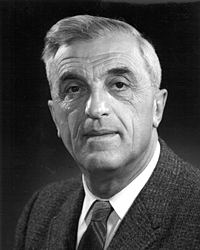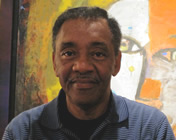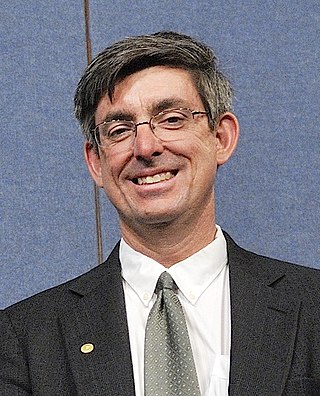Related Research Articles

Felix Bloch was a Swiss-American physicist and Nobel physics laureate who worked mainly in the U.S. He and Edward Mills Purcell were awarded the 1952 Nobel Prize for Physics for "their development of new ways and methods for nuclear magnetic precision measurements." In 1954–1955, he served for one year as the first Director-General of CERN. Felix Bloch made fundamental theoretical contributions to the understanding of ferromagnetism and electron behavior in crystal lattices. He is also considered one of the developers of nuclear magnetic resonance.

Los Alamos National Laboratory is one of the sixteen research and development laboratories of the United States Department of Energy (DOE), located a short distance northwest of Santa Fe, New Mexico, in the American southwest. Best known for its central role in helping develop the first atomic bomb, LANL is one of the world's largest and most advanced scientific institutions.

Harold Paul Furth was an Austrian-American physicist who was a pioneer in leading the American efforts to harness thermonuclear fusion for the generation of electricity. He died of a heart ailment on 21 February 2002.

Stanisław Marcin Ulam was a Polish scientist in the fields of mathematics and nuclear physics. He participated in the Manhattan Project, originated the Teller–Ulam design of thermonuclear weapons, discovered the concept of the cellular automaton, invented the Monte Carlo method of computation, and suggested nuclear pulse propulsion. In pure and applied mathematics, he proved some theorems and proposed several conjectures.
This timeline of nuclear fusion is an incomplete chronological summary of significant events in the study and use of nuclear fusion.

James Leslie Tuck OBE, was a British physicist. He was born in Manchester, England, and educated at the Victoria University of Manchester. Because of his involvement with the Manhattan Project, he was unable to submit his thesis on time and never received his doctoral degree.

Los Alamos is a census-designated place in Los Alamos County, New Mexico, United States, that is recognized as the development and creation place of the atomic bomb—the primary objective of the Manhattan Project by Los Alamos National Laboratory during World War II. The town is located on four mesas of the Pajarito Plateau, and had a population of about 13,200 as of 2020. It is the county seat and one of two population centers in the county known as census-designated places (CDPs); the other is White Rock.
The Perhapsatron was an early fusion power device based on the pinch concept in the 1950s. Conceived by James (Jim) Tuck while working at Los Alamos National Laboratory (LANL), he whimsically named the device on the chance that it might be able to create fusion reactions.
Richard Freeman Post was an American physicist notable for his work in nuclear fusion, plasma physics, magnetic mirrors, magnetic levitation, magnetic bearing design and direct energy conversion.

Conrad Lee Longmire was an American theoretical physicist who was best known as the discoverer of the mechanism behind high-altitude electromagnetic pulse.

Anthony L. Peratt is an American physicist whose most notable achievements have been in plasma discharge petroglyphs, plasma physics, nuclear fusion and the monitoring of nuclear weapons.
Lowell S. Brown was an American theoretical physicist, a retired Staff Scientist and Laboratory Fellow at Los Alamos National Laboratory, and Professor Emeritus of physics at University of Washington. He was a student of Julian Schwinger at Harvard University and a recipient of the John Simon Guggenheim Memorial Foundation Fellowship. Brown authored a book on Quantum Field Theory that has received over 5,000 citations, and he has authored or co-authored over 150 articles that have accumulated over 11,000 citations.

Milton Dean Slaughter is an American theoretical and phenomenological physicist and affiliate professor of physics at Florida International University. Slaughter was a visiting associate professor of physics in the Center for Theoretical Physics, University of Maryland, College Park while on sabbatical from Los Alamos National Laboratory (LANL) of the University of California from 1984 to 1985. He is also chair emeritus and university research professor of physics emeritus at the University of New Orleans (UNO). Prior to joining UNO as chair of the physics department: He was a postdoctoral fellow in the LANL Theoretical Division Elementary Particles and Field Theory Group (T-8); LANL Theoretical Division Detonation Theory and Applications Group (T-14) staff physicist; LANL Theoretical Division affirmative action representative and staff physicist; LANL assistant theoretical division leader for administration and staff physicist (T-DO); LANL Nuclear and Particle Physics Group staff physicist—Medium Energy Physics Division (MP-4); and LANL Historically Black Colleges and Universities (HBCU) project manager (laboratory-wide).

John T. "Jack" Gosling was an American physicist, whose research in heliophysics focused on the large-scale structure and magnetic topology of the solar wind, coronal mass ejections, solar wind and geomagnetic disturbances, magnetic reconnection, collisionless shocks, and particle acceleration in space. Gosling most recently performed research at University of Colorado and was an Elected Fellow of the American Association for the Advancement of Science.
Dmitri Dmitriyevich Ryutov is a Russian theoretical plasma physicist.
The history of nuclear fusion began early in the 20th century as an inquiry into how stars powered themselves and expanded to incorporate a broad inquiry into the nature of matter and energy, as potential applications expanded to include warfare, energy production and rocket propulsion.

John Louis Sarrao is an American physicist. He is the deputy director for science, technology, and engineering at Los Alamos National Laboratory.

Theta-pinch, or θ-pinch, is a type of fusion power reactor design. The name refers to the configuration of currents used to confine the plasma fuel in the reactor, arranged to run around a cylinder in the direction normally denoted as theta in polar coordinate diagrams. The name was chosen to differentiate it from machines based on the pinch effect that arranged their currents running down the centre of the cylinder; these became known as z-pinch machines, referring to the Z-axis in cartesian coordinates.
Alan Herbert Glasser is an American physicist.
Mary Yvonne Pottenger Hockaday is an American physicist who works at the Los Alamos National Laboratory. She was elected a Fellow of the American Association for the Advancement of Science in 2014 and the American Physical Society in 2022.
References
- 1 2 3 4 5 6 7 Dreicer, Harry; Montgomery, David C.; Symon, Keith R.; Turner, Leaf (2002-11-01). "Harold Ralph Lewis". Physics Today. 55 (11): 90–91. Bibcode:2002PhT....55k..90D. doi:10.1063/1.1535021.
- 1 2 3 Lewis, H. Ralph. 1998 resume of Harold Ralph Lewis. April 1998. Box 1, folder 31. Ronald E. Mickens collection on African-American physicists, circa 1950-2008. Niels Bohr Library & Archives, American Institute of Physics. 12 March 2023. https://libserv.aip.org/ipac20/ipac.jsp?session=O67863697N88V.2444105&menu=search&aspect=power&npp=10&ipp=20&spp=20&profile=rev-all&ri=3&source=%7E%21horizon&index=.GW&term=%22harold+ralph+lewis%22&x=0&y=0&aspect=power
- 1 2 Lewis, Harold Ralph (1958). A Method For Measuring Magnetic Fields In Superconductors (Thesis). ProQuest 301884940.
- 1 2 3 4 5 Mickens, Ronald (1999). The African American Presence in Physics. Atlanta, Georgia: National Society of Black Physicists. p. 63.
- ↑ Kotz, David; Makedon, Fillia; Bishop, Matt; Drysdale, Scot; Johnson, Don; and Metaxas, Takis, "Parallel Computer Needs at Dartmouth College" (1992). Open Dartmouth: Peer-reviewed articles by Dartmouth faculty. 3247. https://digitalcommons.dartmouth.edu/cgi/viewcontent.cgi?article=1068&context=cs_tr
- ↑ Pauli, Wolfgang (1973). Pauli Lectures on Physics. MIT Press. ISBN 978-0-262-16049-0.
- ↑ Laboratory, Los Alamos National. "Fellows Directory | Fellows". Los Alamos National Laboratory. Retrieved 2023-03-11.
- ↑ "APS Fellow Archive". www.aps.org. Retrieved 2023-03-11.